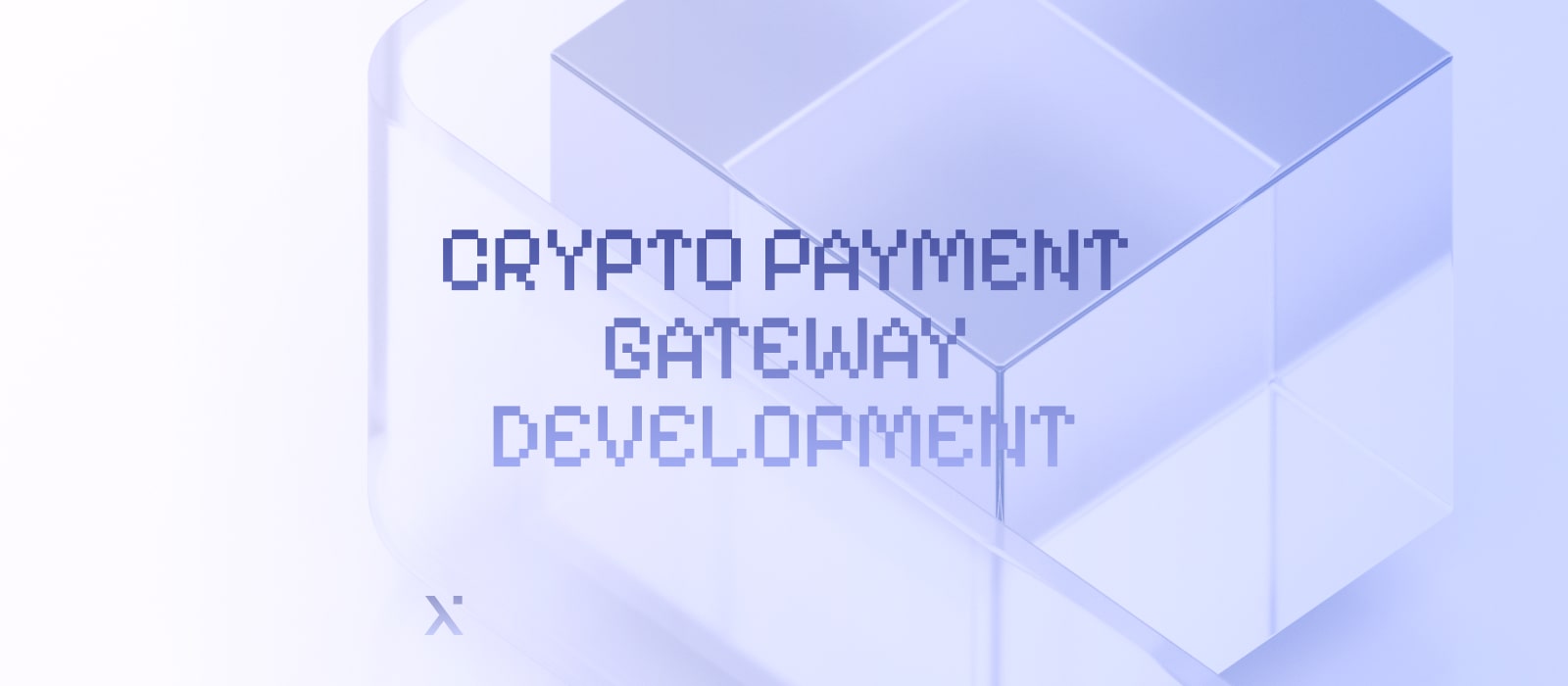That 3% fee on every credit card transaction is a toll you're paying to use an outdated financial highway. We're here to give you the architect's blueprint for building your own private, high-speed expressway directly to your customers.
If you think accepting crypto in 2025 is just about slapping a “Pay with Bitcoin” widget on your checkout page, you’re not just missing the point – it’s like willingly leaving a supercar in the garage while paying for a taxi. The raw, protocol-level power of decentralized finance is waiting to be harnessed.
Here at PixelPlex, our team is architecting the infrastructure. So we’ve pulled our lead engineers and strategists away from their terminals to give you the no-fluff, technically-grounded truth about what a real crypto payment gateway is, how it’s built, and why it’s about to become the most critical component of your entire financial stack.
Why crypto payment gateways become popular
Before we build the future, let’s dissect the present. Think about the journey your money takes right now. A customer clicks ‘buy’. That signal ricochets through a half-dozen intermediaries: your site, a payment processor (Stripe, Adyen), a card network (Visa, Mastercard), the customer’s issuing bank, your acquiring bank. Each entity takes a slice. Let’s say it’s 2.9% for the payment processor + $0.30 for a card network or bank. For a business with $1M in revenue, that’s $29,000+ straight off the top.
Then there’s the operational drag. A cross-border SWIFT transfer can take 3-5 business days, lost in a black box of correspondent banks. And let’s not forget the chargeback – the bane of every online merchant. In 2024, merchants globally lost over $150 billion to chargeback fraud, a figure that continues to climb. You spend man-hours and money on dispute resolution software, fighting a system where you are presumed guilty.
This is the backdrop against which crypto payments are emerging. With a global crypto user base now topping 600 million, you have a G7-sized economy filled with people accustomed to near-instant settlement and transaction finality. They see the old system for what it is: an inefficient, expensive relic. They want to pay you directly. Your job is to build a modern port to receive their funds.
The gateway deconstructed: how it works
A cryptocurrency payment gateway is a sophisticated piece of middleware that acts as a universal financial translator, a hyper-secure armored car service, and an automated finances management system all in one.
Let’s dive into the anatomy of a single transaction:
The payment request
Your eCommerce store’s backend makes an API call: “Requesting payment for Order #123, value $100.” The gateway’s engine kicks in, querying multiple liquidity providers (like Kraken or Binance) via API to get the real-time exchange rate for BTC, ETH, USDC, etc. It locks in a rate for a 10-minute window and generates a unique, single-use payment address and a QR code representing the exact crypto amount. This crucial step shields you from price volatility during the payment process.
The user reply
The customer scans the QR code and authorizes the transaction from their wallet. The transaction is broadcast to the respective blockchain network and enters the “mempool” – a waiting room for unconfirmed transactions. Your gateway is now actively monitoring the network for this specific transaction hash.
Confirmation & finality
This is where security meets speed.
Proof-of-Work (e.g., Bitcoin): The gateway waits for a pre-set number of “confirmations.” Each confirmation is a new block added to the chain after the one containing your transaction, making it exponentially harder to reverse. For a small purchase, 1-2 confirmations might suffice (10-20 minutes). For a high-value sale, you’d configure the gateway to wait for 6 confirmations (about an hour), rendering the transaction practically irreversible.
Proof-of-Stake & Layer-2s (e.g., Polygon, Arbitrum, Lightning): This is the fast lane. On a Layer-2 network like Polygon or Bitcoin’s Lightning Network, confirmation is achieved in seconds for fractions of a cent. The Lightning Network does this via off-chain payment channels, only settling the final balance on the main blockchain later. This is the technology that makes buying a coffee with crypto feasible.
Popular types of blockchain consensus algorithms – download our free guide here
The settlement & reconciliation
Once confirmed, the gateway’s job is done, right? Wrong. Now comes the treasury function. The crypto is credited to your gateway account. You can have a rule set: “Automatically convert all incoming BTC and ETH to USDC to eliminate volatility,” or “Convert 70% to USD and deposit to our bank account daily, keep 30% as ETH.” The gateway executes these swaps via its liquidity providers and provides a dashboard with clear, exportable reports for your accounting team. This is a complete, automated payment lifecycle.
How to Start a Crowdfunding Platform
Blockchain Technology ETFs: A Smarter Way to Invest in Crypto Without Buying Bitcoin
Custodial vs. Non-Custodial Wallet: Full Guide
Crypto gateways options
Choosing how to accept crypto involves a classic “build vs. buy” decision. The path you choose will define your costs, customer experience, and level of control. Here’s a look at the four main approaches.
Full-service custodial gateways
Think of this model, offered by players like BitPay, as an all-inclusive service. It’s designed for businesses that want the benefits of accepting digital currencies with zero technical hassle or price risk. The service handles everything – receiving the crypto, instantly converting it to your preferred currency, and depositing the funds into your bank account.
The primary trade-off is paying a recurring transaction fee (typically around 1%) for this convenience. While you gain simplicity and are fully shielded from volatility, you cede control over the user experience and rely on a third party’s infrastructure and branding.
Non-custodial software tools
This approach, exemplified by Coinbase Commerce or the open-source BTCPay Server, is like having a direct deposit setup for your crypto. The software facilitates a payment directly from the customer’s wallet to your own, giving you immediate and full control of your funds. It’s ideal for tech-savvy merchants who prioritize self-custody and minimal fees.
The core trade-off is responsibility. In exchange for control and dramatically lower costs, your business assumes all the risk of crypto price volatility and is solely responsible for securing your own wallets and private keys.
Multi-coin processors
A multi-coin processor like CoinPayments acts as a universal travel adapter, built to connect with the widest possible array of cryptocurrencies. This option is perfect for businesses targeting niche online communities that use specific “altcoins.” These gateways offer unmatched flexibility, allowing you to accept thousands of different tokens. The main consideration here is managing complexity. While you maximize your market reach, you must also navigate the risks associated with the extreme volatility and lower liquidity of many niche assets.
The custom-built gateway
Finally, there is the option to build your own bespoke gateway with a specialized crypto payment solutions vendor like PixelPlex. This path is for established enterprises that view their payment infrastructure as a core strategic asset.
The trade-off is a significant upfront investment of time and capital for unparalleled control. In return, you get a platform perfectly tailored to your brand and operations, the ability to build unique competitive features, and the potential to eliminate third-party transaction fees entirely at scale.
The tech stack you need
For those who want to look under the hood, building a gateway involves critical architectural decisions. This is core to the cryptocurrency payment gateway development process.
Backend language
Performance is key. Go and Rust are top contenders for their concurrency and memory safety, ideal for handling many simultaneous transactions and interacting with blockchain nodes. Node.js is also a popular choice for its rapid development ecosystem, especially for the API layers. Overall you can choose out of the best programming languages in the market, based on your business needs.
Architecture
A microservices architecture is almost always the right call. You can isolate the wallet service, the transaction monitoring service, the API gateway, and the invoicing engine. This improves scalability (you can scale just the parts under heavy load) and resilience (an issue in one service doesn’t bring down the whole platform).
Database
You’ll likely use a hybrid approach. A relational database like PostgreSQL is perfect for storing immutable transaction data, user accounts, and financial records due to its ACID compliance. A NoSQL database like MongoDB or Redis might be used for caching real-time price feeds or managing session data.
Node interaction
Do you run your own full blockchain nodes or use a Blockchain-as-a-Service (BaaS) provider like Infura or Alchemy?
Running nodes: Gives you ultimate control, no third-party reliance, and can be cheaper at massive scale. The downside is significant DevOps overhead: maintenance, security, and storage.
Using BaaS: Massively accelerates development time and removes the DevOps burden. You get reliable access to blockchain data via a simple API key. The trade-off is cost at scale and reliance on a third party. Most projects start with BaaS and may migrate to their own nodes later.
Blockchain Database vs Traditional Database
How to Create A White Label Crypto Exchange in 7 steps
Blockchain in Payment Services: Trends, Technologies, and Development Best Practices
What about the compliance?
Ignoring regulations is a speedrun to disaster. A robust payment gateway for cryptocurrency must be built with compliance in mind.
- AML/KYC: Anti-Money Laundering and Know Your Customer regulations are paramount, the Know-Your-Transaction algorithms are often implemented too. For a custodial gateway, you’ll need a process to verify the identity of your merchants.
- Transaction monitoring software development: This is where it gets interesting. You must integrate with a chain analysis service like Chainalysis, TRM Labs, or Elliptic. Their APIs can score incoming transactions, flagging funds that have originated from sanctioned addresses, darknet markets, or known scams. Your gateway can then be configured to automatically freeze or reject these transactions, protecting your business from regulatory blowback.
- Global frameworks: Be aware of frameworks and crypto regulations like the FATF “Travel Rule” and Europe’s MiCA (Markets in Crypto-Assets) regulation. A good cryptocurrency payment gateway development company will build a system flexible enough to adapt to these evolving rules.
Crypto payments in the future
The technology isn’t standing still. Here’s what the best payment gateway for cryptocurrency will incorporate next:
Seamless cross-chain swaps
The user wants to pay with Solana-based USDC, but you want to receive assets on the Ethereum network. The gateway of the future will use cross-chain bridges and DEX aggregators to perform this swap invisibly in the background. The user pays with what they have, you receive what you want.
DeFi-powered treasury management
Why let your stablecoin earnings sit idle? The next frontier is integrating protocols like Aave or Compound directly into the merchant dashboard of the stablecoin development solutions. With a click, you can deposit your USDC earnings into a lending protocol to earn a yield, turning your payment gateway into a profit center.
The rise of CBDCs
Central Bank Digital Currencies are coming. Gateways will need to be architected to handle both decentralized cryptocurrencies and these new state-issued digital currencies, acting as the bridge between the two worlds.
AI-driven risk analysis
Beyond just flagging known bad addresses, AI will be used to detect anomalous behavior – a merchant who suddenly starts processing 100x their normal volume, or a pattern of payments that suggests structuring. This provides a dynamic, intelligent layer of security.
Guide to budgeting for your crypto payment gateway
Let’s move past ballpark figures and into a detailed budgetary forecast. The most common point of failure for ambitious tech projects isn’t a flaw in the code – it’s a flaw in the budget. Building a cryptocurrency payment gateway is like commissioning the construction of a new, highly secure bank vault. Every stage, from the initial blueprint to the ongoing security patrols, has a specific and critical cost associated with it.
Underestimating the payment gateway development cost leads to cut corners, and in the world of digital assets, a single cut corner can lead to a catastrophic and public failure. Here, we will dissect the entire financial lifecycle of your gateway, from initial ideation to long-term operational expenses. This is the transparent breakdown you need to build a realistic budget and make an informed investment decision.
Thinking about creating your own cryptocurrency? From A to Z, we’re ready to take up the process
Part 1: The Capital Expenditure (CapEx)
This is the one-time investment required to design, build, and launch your platform. We can break this down into four distinct, sequential phases.
Phase 1: Strategy, research, and architecture (the blueprint)
Est. cost: $25,000 – $45,000 | Est. timeline: 4-6 weeks
Attempting to build without a comprehensive blueprint is financial malpractice. This initial phase is the most critical for ensuring the final product aligns with your business goals and is technically sound.
Business analysis & feature prioritization ($8,000 – $12,000): This involves workshops with your stakeholders, conducted by senior business analysts and product managers. The goal is to define the precise feature set, map out user flows, prioritize the MVP (Minimum Viable Product) vs. future enhancements, and produce a detailed product requirements document.
Technical architecture & security modeling ($10,000 – $18,000): Your lead architects and security engineers design the system’s core. This includes selecting the tech stack, designing a scalable microservices architecture, modeling the database schemas, and, most importantly, creating a security and threat model. This is where decisions about wallet infrastructure (Hot/Cold/MPC) and key management are made. A trusted cryptocurrency wallet development company will help you figure everything out.
UI/UX design services & prototyping ($7,000 – $15,000): Designers create a visually appealing and, more importantly, intuitive interface for both the merchant dashboard and the customer checkout experience. This phase delivers high-fidelity, interactive prototypes that you can test with real users before a single line of code is written, saving a fortune in development rework later.
Phase 2: Core development & implementation (the build)
Est. cost: $90,000 – $200,000+ | Est. timeline: 4-7 months
This is the heavy engineering lift and constitutes the largest portion of the initial investment. The cost here is directly proportional to the complexity of the features defined in Phase 1.
Backend engineering ($60,000 – $130,000+):
- Wallet infrastructure: The most complex component. Implementing white label crypto wallet development, managing private keys (integrating with Hardware Security Modules or KMS), and orchestrating funds between hot (online) and cold (offline) storage.
- Blockchain integration services: Setting up and maintaining your own full nodes or, more commonly, integrating with BaaS providers like Alchemy or Infura for multiple blockchains.
- Transaction processing engine: Building the state machine that reliably tracks every payment from pending to confirmed to failed to settled.
- Cryptocurrency exchange development services: Writing robust API integrations with multiple crypto exchanges or complex white label crypto exchange software development to guarantee the best real-time rates for crypto-to-fiat conversions.
Frontend engineering ($30,000 – $70,000):
- Merchant dashboard: Developing a feature-rich, responsive web application (typically using React, Vue, or Angular) where your clients can manage their funds, track analytics, and generate reports.
- eCommerce plugins: This is not trivial. Building, testing, and maintaining official plugins for platforms like Shopify, WooCommerce, and Magento requires dedicated development effort to ensure compatibility and ease of use.
Phase 3: Security & testing (The fortification)
Est. cost: $20,000 – $50,000+ | Est. timeline: concurrent with Phase 2, with a dedicated 4-week final audit
In finance, testing and security have a distinct line item in the budget.
- Internal quality assurance ($10,000 – $20,000): The cost of QA engineers who write and execute thousands of automated tests (unit, integration, end-to-end) and perform manual exploratory testing to catch bugs.
- Third-party penetration test & smart contract audit ($10,000 – $30,000+): This is non-negotiable. You hire a reputable external cybersecurity firm to act as an ethical hacker. They will attack your platform and audit your codebase to find vulnerabilities you missed. The final report is your proof of due diligence. The cost can be significantly higher if your platform includes its own smart contracts, which require specialized and expensive audits.
Part 2: The Operational Expenditure (OpEx)
A common pitfall for businesses is focusing solely on the initial payment gateway development cost. The Total Cost of Ownership (TCO) includes significant ongoing operational costs. You must budget for these monthly and annual expenses.
Core technology & infrastructure
Est. monthly cost: $2,000 – $10,000+
- Cloud hosting (e.g., AWS, GCP): Your platform needs servers. The cost will depend on your traffic but expect to pay for virtual machines, databases, load balancers, and data transfer. A starting point is often $1,000-$3,000/month, scaling with user load.
- Blockchain-as-a-Service (BaaS) fees: Unless you’re running all your own nodes, you’ll pay providers like Alchemy or Infura. Their pricing is based on usage, and for a production-level gateway, this can range from $500 to $5,000+/month.
- Logging, monitoring & alerting services: Tools like Datadog, New Relic, or Sentry are essential for monitoring platform health and are subscription-based, often costing $500+/month.
Licensing, compliance & liquidity
Est. annual cost: $20,000 – $70,000+
- Chain analysis service subscription: Integrating a tool like Chainalysis or TRM Labs for AML compliance is mandatory. These services are not cheap, with annual licenses often starting at $15,000 and going up based on the volume of transactions you screen.
- Liquidity provider fees: While not always an explicit fee, the spread you get on crypto-to-fiat conversions is an implicit cost. Some providers may also have minimum volume commitments or API access fees.
- External security scans: You should budget for at least one annual penetration test to check for new vulnerabilities, costing $10,000-$20,000 per year.
Personnel & maintenance
Est. monthly cost: $5,000 – $25,000+
- Developer retainer: No software is ever “done.” You’ll need an ongoing retainer with your cryptocurrency payment gateway development company or your in-house team for bug fixes, security patches, performance tuning, and adding support for new blockchains or features. This can range from a few dozen hours to a full-time dedicated team.
- Customer & technical support: You will need staff to handle merchant inquiries and technical issues.
| Cost category | One-time investment | Ongoing expense | Notes |
| Phase 1: Blueprint | $25,000 – $45,000 | – | Don’t skip this. Sets the foundation for success. |
| Phase 2: The Build | $90,000 – $200,000+ | – | The bulk of the initial development effort. |
| Phase 3: Fortification | $20,000 – $50,000+ | – | Non-negotiable for any financial application. |
| Tech infrastructure | – | $2,000 – $10,000+ / month | Cloud hosting, BaaS subscriptions, monitoring tools. |
| Compliance & licensing | – | $20,000 – $70,000+ / year | AML/KYC tools, security audits. |
| Maintenance & support | – | $5,000 – $25,000+ / month | Developer retainer and support staff. |
| TOTALS | $135,000 – $295,000+ | ~$8,000 – $35,000+ / month | Illustrative ranges. Actual costs depend on scope. |
While these numbers are significant, it’s crucial to contextualize them. This is an investment in mission-critical infrastructure. Compare this payment gateway development cost to the 2.9% “tax” you may be paying on every single transaction processed through traditional rails. For a business with millions in revenue, the gateway can pay for itself in saved fees and reduced operational drag within a surprisingly short timeframe.
Build your crypto payment gateway
The choice facing businesses today is stark. You can continue paying the exorbitant tolls on the crumbling, centralized financial highway, or you can invest in building your own modern, efficient, and global infrastructure. A custom cryptocurrency payment gateway is that infrastructure. It’s your direct line to a new global economy.
Building this demands a rare fusion of expertise across distributed systems, cryptography, financial regulations, and secure application design. It’s why you partner with a specialized cryptocurrency payment gateway development company.
At PixelPlex, we’re the architects and engineers who have been building these systems for over a decade. We understand the trade-offs, the security pitfalls, and the architectural patterns that separate a world-class gateway from a catastrophic failure. If you’re ready to move beyond simple widgets and build a true financial engine for your business, let’s have a conversation. We’ll help you architect the future of your revenue.
FAQ
To cut costs with significantly lower fees, completely eliminate chargeback fraud, and gain access to a large and growing global customer base that prefers to pay with digital assets.
A secure, professionally-built custom gateway typically takes 5 to 9 months. This timeline ensures proper planning, development, and indispensable security auditing before launch.
Budget for an initial investment starting around $135,000 for development and launch. You must also plan for ongoing operational costs for hosting, security, and maintenance.
These are solved by the gateway’s core functions. Price volatility is eliminated through instant conversion to your preferred fiat currency (like Euros), and security is ensured with bank-grade protocols and mandatory third-party audits.
For three key advantages: 1) Complete control over your brand and customer experience, 2) Unique features that create a competitive edge, and 3) Better profitability at scale by eliminating third-party transaction fees.




